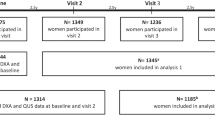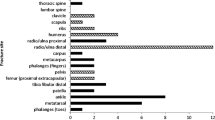Abstract
Quantitative ultrasound measurement (QUS) and bone mineral density (BMD) have each been shown to predict fracture risk in women. The present study examined whether a combination of QUS and BMD could improve the predictive accuracy of fracture risk. This is a population-based prospective study which involved 454 women and 445 men aged 62–89 years. Femoral neck BMD (FNBMD) was measured by DXA and calcaneal QUS was measured as broadband ultrasound attenuation (BUA) by a CUBA sonometer. Fragility fracture was ascertained by X-ray reports during the follow-up period, which took place between mid-1989 and 2009. During the follow-up period (median 13 years, range 11–15), 75 men and 154 women sustained a fragility fracture. In women, the model with FNBMD and BUA had a higher AUC compared to that without BUA (0.73 vs. 0.71 for any fracture, 0.81 vs. 0.77 for hip fracture, and 0.72 vs. 0.70 for vertebral fracture). Reclassification analysis yielded a total net reclassification improvement of 7.3%, 11.1%, and 5.2% for any, hip, and vertebral fractures, respectively. For men, the addition of BUA to FNBMD did not improve the predictive power for any, hip, or vertebral fracture. These results suggest that calcaneal QUS is an independent predictor of fracture risk and that a combination of QUS and BMD measurement could improve the predictive accuracy of fracture risk in elderly women.

Similar content being viewed by others
References
Nguyen ND, Ahlborg HG, Center JR, Eisman JA, Nguyen TV (2007) Residual lifetime risk of fractures in women and men. J Bone Miner Res 22:781–788
Bliuc D, Nguyen ND, Milch VE, Nguyen TV, Eisman JA, Center JR (2009) Mortality risk associated with low-trauma osteoporotic fracture and subsequent fracture in men and women. JAMA 301:513–521
Center JR, Nguyen TV, Schneider DS, Sambrook P, Eisman JA (1999) Mortality after all major types of osteoporotic fracture in men and women: an observational study. Lancet 353:878–882
Johnell O, Kanis JA (2006) An estimate of the worldwide prevalence and disability associated with osteoporotic fractures. Osteoporos Int 17:1726–1733
Randell A, Sambrook P, Nguyen TV, Lapsley H, Jones G, Kelly PJ, Eisman JA (1995) Direct clinical and welfare costs of osteoporotic fractures in elderly men and women. Osteoporos Int 5:427–432
Faulkner KG (2005) The tale of the T-score: review and perspective. Osteoporos Int 16:347–352
Stone KL, Seeley DG, Lui LY, Cauley JA, Ensrud K, Browner WS, Nevitt MC, Cummings SR (2003) BMD at multiple sites and risk of fracture of multiple types: long-term results from the Study of Osteoporotic Fractures. J Bone Miner Res 18:1947–1954
Legrand E, Chappard D, Pascaretti C, Duquenne M, Rondeau C, Simon Y, Rohmer V, Basle M-F, Audran M (1999) Bone mineral density and vertebral fractures in men. Osteoporos Int 10:265–270
Njeh CF, Hodgskkinson R, Currey JD, Langton CM (1996) Orthogonal relationship between ultrasound velocity and material properties of bovine cancelleous bone. Med Eng Phys 18:373–381
Gluer CC, Wu CY, Jergas M, Goldstgein SA, Genant HK (1994) Three quantitative parameters reflect bone structure. Calcif Tissue Int 55:46–52
Cortet B, Boutry N, Dubios P, Legroux-Gerot I, Cotton A, Marchandise X (2004) Does quantitative ultrasound of bone reflect more bone density than bone microarchitecture? Calcif Tissue Int 74:60–67
Langton CM, Palmer SB, Porter RW (1984) The measurement of broadband ultrasonic attenuation in cancellous bone. Eng Med 13:89–91
Gnudi S, Gualtiori G, Malavolta N (1998) Simultaneous densitometry and quantitative bone sonography in the estimation of osteoprotic fracture risk. Br J Radiol 71:625–629
Gluer CC, Eastell R, Reid DM, Felsenberg D, Roux C, Barkmann R, Timm W, Blenk T, Armbrecht G, Stewart A, Clowes J, Tyhomasius FE, Kotlta S (2004) Association of five quantitative ultrasound devices and bone densitometry with osteoporotic vertebral fractures in a population-based sample: the OPUS study. J Bone Miner Res 19:782–793
Nguyen TV, Center JR, Eisman JA (2004) Bone mineral density–independent association of quantitative ultrasound measurements and fracture risk in women. Osteoporos Int 15:942–947
Njeh C, Hans D, Fuerst T, Gluer CC, Genant HK (1999) Quantitative ultrasound: assessment of osteoporosis and bone status. Martin Dunitz, London
Bauer DC, Gluer CC, Genant HK, Stone K (1995) Quantitative ultrasound and vertebral fracture in postmenopausal women. J Bone Miner Res 10:353–357
Diez-Perez A, Gonzalez-Macias J, Marin F, Abizanda M, Alvarez R, Gimeno A, Pegenaute E, Vila J (2007) Prediction of absolute risk of non-spinal fractures using clinical risk factors and heel quantitative ultrasound. Osteoporos Int 18:629–639
Mautalen C, Vega E, Gonzalez D, Carrilero P, Otano A, Silberman F (1995) Ultrasound and dual X-ray absorptiometry densitometry in women with hip fracture. Calcif Tissue Int 57:165–168
Grampp S, Genant HK, Mathur A, Lang P, Jergas M, Takada M, Gluer CC, Lu Y, Chavez M (1997) Comparison of noninvasive bone mineral measurements in assessing age-related loss, fracture discrimination, and diagnostic classification. J Bone Miner Res 12:697–711
Frost ML, Blake GM, Fogelman I (2000) Does quantitative ultrasound imaging enhance precision and discrimination? Osteoporos Int 11:425–433
Hollaender R, Hartl F, Krieg MA, Tyndall A, Geuckel C, Buitrago-Tellez C, Manghani M, Kraenzlin M, Theiler R, Hans D (2009) Prospective evaluation of risk of vertebral fractures using quantitative ultrasound measurements and bone mineral density in a population-based sample of postmenopausal women: results of the Basel Osteoporosis Study. Ann Rheum Dis 68:391–396
Khaw KT, Reeve J, Luben R, Bingham SA, Welch A, Wareham N, Oakes S, Day N (2004) Prediction of total and hip fracture risk in men and women by quantitative ultrasound of the calcaneus: EPIC-Norfolk prospective population study. Lancet 363:197–202
Moayyeri A, Kaptoge S, Dalzell N, Luben R, Wareham N, Bingham SA, Reeve J, Khaw KT (2009) The effect of including quantitative heel ultrasound in models for estimation of 10-year absolute risk of fracture. Bone 45:180–184
Frost ML, Blake GM, Fogelman I (2001) Does the combination of quantitative ultrasound and dual energy X-ray absorptiometry improve fracture discrimination? Osteoporos Int 12:471–477
Nguyen TV, Eisman JA, Kelly PJ, Sambrook P (1996) Risk factors for osteoporotic fractures in elderly men. Am J Epidemiol 144:255–263
Simons LA, McCallum J, Simons J, Powell I, Ruys J, Heller R, Lerba C (1990) The Dubbo study: an Australian prospective community study of the health of elderly. Aust N Z J Med 20:783–789
Jones G, Nguyen TV, Sambrook P, Kelly PJ, Gilbert C, Eisman JA (1994) Symptomatic fracture incidence in elderly men and women: the Dubbo Osteoporosis Epidemiology Study (DOES). Osteoporos Int 4:277–282
Nguyen ND, Frost SA, Center JR, Eisman JA, Nguyen TV (2007) Development of a nomogram for individualizing hip fracture risk in men and women. Osteoporos Int 18:1109–1117
Hanley JA, McNeil BJ (1982) The meaning and use of the area under the receiver operating characteristic (ROC) curve. Radiology 143:29–36
Vexler A, Liu A, Eliseeva E, Schisterman EF (2008) Maximum likelihood ratio tests for comparing the discriminatory ability of biomarkers subject to limit of detection. Biometrics 64:895–903
Pencina M, D’Agostino RB Sr, D’Agostino RB Jr, Vasan RS (2008) Evaluating the added predictive ability of a new marker: from area under the ROC curve to reclassification and beyond. Stat Med 27:157–172
Siminoski K, Leslie WD, Frame H, Hodsman A, Josse RG, Khan A, Lentle BC, Levesque J, Lyons DJ, Tarulli G, Brown JP (2007) Recommendations for bone mineral density reporting in Canada: a shift to absolute fracture risk assessment. J Clin Densitom 10:120–123
R Development Core Team (2006) A language and environment for statistical computing, http://www.r-project.org/. R Foundation for Statistical Computing, Vienna
Nguyen ND, Eisman JA, Center JR, Nguyen TV (2007) Risk factors for fracture in nonosteoporotic men and women. J Clin Endocrinol Metab 92:955–962
Pluijm SM, Graafmans WC, Bouter LM, Lips P (1999) Ultrasound measurements for the prediction of osteoporotic fractures in elderly people. Osteoporos Int 9:550–556
Hans D, Dargent-Molina P, Schott AM, Sebert JL, Cormier C, Kotzki PO, Delmas PD, Pouilles JM, Breart G, Meunier PJ (1996) Ultrasonographic heel measurements to predict hip fracture in elderly women: the EPIDOS prospective study. Lancet 348:511–514
Huopio J, Kroger H, Honkanen R, Jurvelin J, Saarelainen J, Alhava E (2004) Calcaneal ultrasound predicts early psotmenopausal fractures as well as axial BMD. A prospective study of 422 women. Osteoporos Int 15:190–195
Bauer DC, Ewing SK, Cauley JA, Ensrud KE, Cummings SR, Orwoll ES (2007) Quantitative ultrasound predicts hip and non-spine fracture in men: the MrOS study. Osteoporos Int 18:771–777
Cheng S, Njeh CF, Fan B, Cheng X, Hans D, Wang L, Fuerst T, Genant HK (2002) Influence of region of interest and bone size on calcaneal BMD: implications for the accuracy of quantitative ultrasound assessments at the calcaneus. Br J Radiol 75:59–68
Toyras J, Kroger H, Jurvelin SJ (1999) Bone properties as estimated by mineral density, ultrasound attenuation, and velocity. Bone 25:725–731
Ruff CB, Hayes WC (1988) Sex differences in age-related remodeling of the femur and tibia. J Orthop Res 6:886–896
Trebacz H, Natali A (1999) Ultrasound velocity and attenuation in cancellous bone samples from lumbar vertebrae and calcaneus. Osteoporos Int 9:99–105
Bauer DC, Gluer CC, Cauley JA, Vogt TM, Ensrud K, Genant HK, Black DM (1997) Broadband ultrasound attenuation predicts fractures strongly and independently of densitometry in older women: a prospective study. Arch Intern Med 157:629–634
Kattan MW, Zelefsky MJ, Kupelian PA, Scardino PT, Fuks Z, Leibel SA (2000) Pretreatment nomogram for predicting the outcome of three-dimensional conformal radiotherapy in prostate cancer. J Clin Oncol 18:3352–3359
Fernando J, Bianco J (2006) Nomograms and medicine. Eur Urol 50:884–886
Kanis JA, Johnell O, Oden A, Johansson H, McCloskey EV (2008) FRAX and the assessment of fracture probability in men and women from the UK. Osteoporos Int 19:385–397
Sandhu SK, Nguyen ND, Center JR, Pocock NA, Eisman JA, Nguyen TV (2009) Prognosis of fracture: evaluation of predictive accuracy of the FRAX algorithm and Garvan nomogram. Osteoporos Int 21:863–871
Acknowledgement
We gratefully acknowledge the assistance of Sr. Janet Watters, Donna Reeves, Shaye Field, and Jodie Ratleg for the interview, data collection, and measurement of BMD. We thank Mr. J. McBride and the IT group of the Garvan Institute of Medical Research for the management of the database. The study was partly supported by the Australian National Health and Medical Research Council (NHMRC). N. D. N. is supported by a fellowship from the AMBeR (Australian Medical Bioinformatics Resource). T. V. N. is supported by a senior research fellowship from the Australian NHMRC.
Author information
Authors and Affiliations
Corresponding author
Additional information
J.A. Eisman has served as consultant/advisory role to Amgen, deCode, Eli Lilly, Merck Sharp & Dohme, Novartis, Sanofi-Aventis, and Servier. J. R. Center has served as consultant/advisory role to Amgen, Merck Sharp & Dohme, Novartis, and Sanofi-Aventis. T.V. Nguyen has served as consultant/advisory role to Merck Sharp & Dohme, Novartis, Roche, and Servier. All other authors have stated that they have no conflict of interest.
Rights and permissions
About this article
Cite this article
Chan, M.Y., Nguyen, N.D., Center, J.R. et al. Absolute Fracture-Risk Prediction by a Combination of Calcaneal Quantitative Ultrasound and Bone Mineral Density. Calcif Tissue Int 90, 128–136 (2012). https://doi.org/10.1007/s00223-011-9556-3
Received:
Accepted:
Published:
Issue Date:
DOI: https://doi.org/10.1007/s00223-011-9556-3




